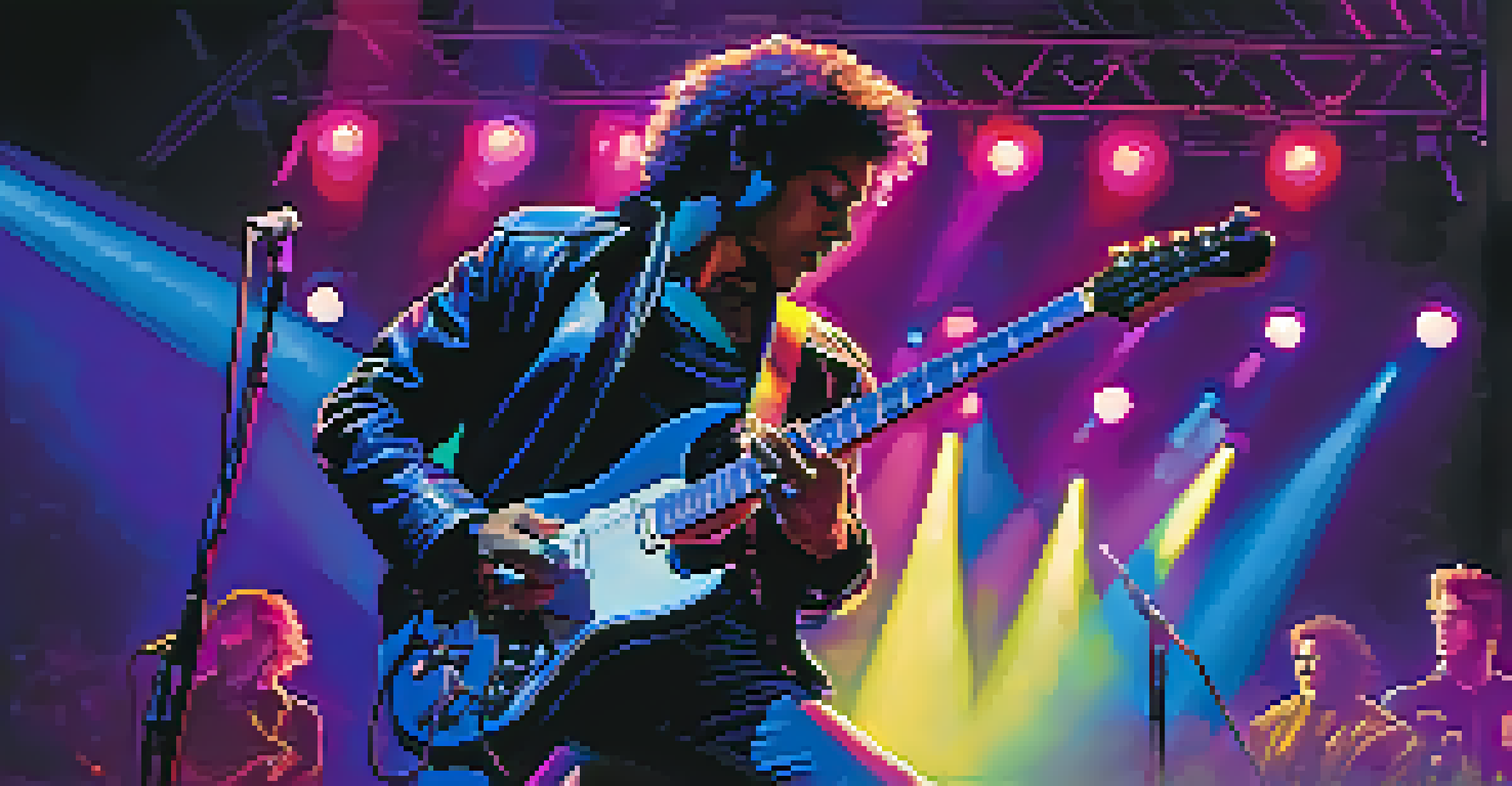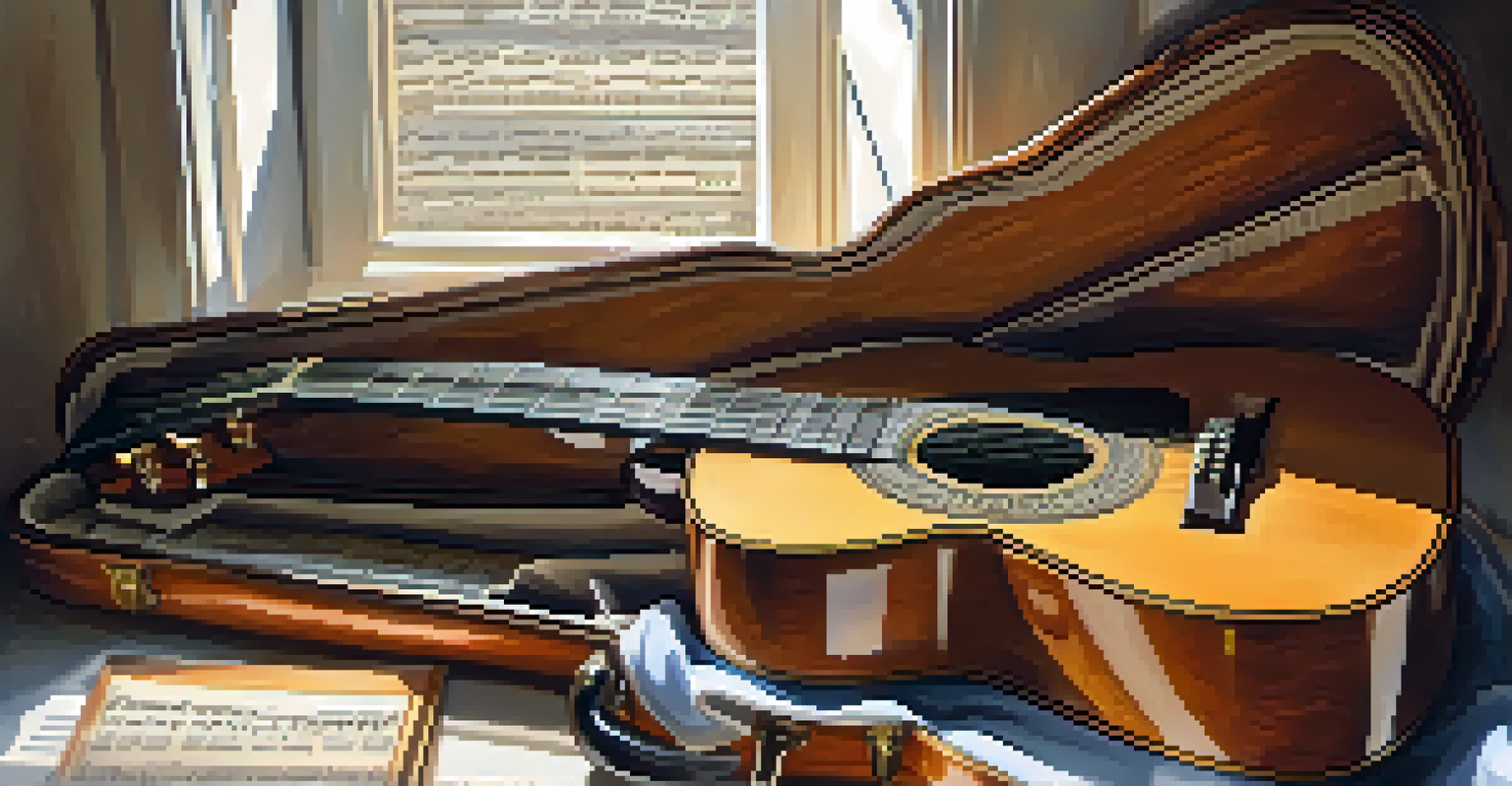Understanding the Different Styles of Guitar Playing

The Basics of Guitar Playing Styles Explained
Guitar playing styles can vary widely, each with its own unique flair and technique. Understanding these styles helps you appreciate the instrument more deeply and discover where your preferences lie. Essentially, a guitar style encompasses not just how you play, but also the musical genres and techniques involved.
The guitar is a miniature orchestra in itself.
Whether you're strumming chords in folk music or shredding in rock, each style reflects the artist's personality and influences. This diversity is what makes guitar such a versatile instrument, appealing to a broad range of musicians and listeners alike. As we delve deeper into the various styles, you’ll see how they interconnect and influence one another.
So, let’s strum our way through the different styles, starting with the most foundational elements that every guitarist should know.
Acoustic Guitar: The Warmth of Fingerstyle and Strumming
Acoustic guitar playing often evokes a sense of intimacy and warmth, making it a popular choice for singer-songwriters and folk musicians. Fingerstyle techniques involve plucking the strings with your fingers rather than a pick, allowing for intricate melodies and harmonies. This style can create a rich, layered sound that captivates listeners.

On the other hand, strumming is about rhythm and energy, often used in upbeat music where a full, resounding sound is desired. Think of campfire sing-alongs where everyone joins in, fueled by the rhythmic strumming of an acoustic guitar. Both techniques have their own charm and can be used in various musical genres, from country to blues.
Guitar Styles Reflect Personal Expression
Each guitar playing style offers unique techniques and influences that allow musicians to express their individuality.
Mastering these techniques not only enhances your playing but also helps you express yourself through the music you create.
Electric Guitar: From Rock to Jazz and Beyond
The electric guitar is synonymous with rock music, but its versatility extends far beyond that. With the ability to manipulate sound through amplifiers and effects, electric guitarists can create a wide range of tones, from gritty to smooth. This adaptability is what makes the electric guitar a staple in genres like rock, blues, jazz, and even pop.
Music is the shorthand of emotion.
For instance, the sharp riffs of rock legends showcase powerful solos, while jazz guitarists often employ complex chord progressions and improvisation. Each style demands a different approach, whether it’s fast finger work in rock or subtle chord changes in jazz. The electric guitar allows musicians to explore their creativity, pushing the boundaries of sound.
As you dive into electric guitar playing, think about the genre that resonates with you. This can guide your practice and help you develop a unique style.
Classical Guitar: The Art of Precision and Technique
Classical guitar is often viewed as the pinnacle of guitar playing styles, emphasizing precision, technique, and musicality. Played with nylon strings, this style typically features fingerpicking, where each finger has a specific role in creating beautiful melodies. The intricate compositions often require years of practice to master.
Classical guitarists frequently perform pieces from composers like Bach and Tarrega, showcasing the instrument's melodic capabilities. This style also emphasizes proper posture and hand positioning, fostering a disciplined approach to playing. Engaging with classical guitar can deepen your understanding of music theory and composition.
Mastering Techniques Enhances Playing
Whether through fingerstyle, strumming, or advanced techniques, mastering guitar skills enhances your musical expression.
If you're interested in exploring this style, consider taking lessons or starting with simple classical pieces to build your skills.
Blues Guitar: Expressive Techniques and Soulful Sound
Blues guitar is all about emotion and expression, often characterized by the use of bends, slides, and vibrato. This style has roots in African American history and serves as a foundation for many modern music genres. The soulful sound of blues can evoke deep feelings, making it a powerful form of artistic expression.
Many iconic guitarists, like B.B. King and Eric Clapton, have shaped the blues genre, showcasing the guitar's ability to convey raw emotion. Techniques like the 12-bar blues progression provide structure while allowing for improvisation that feels spontaneous and personal. These elements make blues guitar both accessible for beginners and challenging for advanced players.
If you're drawn to storytelling through music, blues guitar may be the perfect style for you to explore.
Folk Guitar: Storytelling Through Strumming and Picking
Folk guitar is deeply rooted in storytelling, often accompanying lyrics that reflect personal or societal experiences. This style typically uses simple chord progressions, making it easy for beginners to pick up and play. Strumming and fingerpicking techniques are both prevalent, creating a warm, inviting sound that resonates with listeners.
Artists like Bob Dylan and Joan Baez have popularized folk guitar, weaving tales of love, struggle, and social change into their music. The simplicity of folk guitar allows for emotional connection, drawing audiences in with relatable themes. It’s a style that encourages participation, often leading to sing-alongs and communal experiences.
Exploration Leads to Unique Sound
Discovering your unique guitar style involves experimenting with different genres and blending techniques to create a personal sound.
If you're interested in expressing your own stories through music, folk guitar provides a beautiful platform to do so.
Metal Guitar: Speed, Precision, and Thrilling Techniques
Metal guitar is known for its aggressive sound and technical prowess, often featuring fast riffs and complex solos. This style relies heavily on distortion and effects, creating a powerful auditory experience that resonates with fans. Key techniques include palm muting, sweep picking, and alternate picking, all of which contribute to the genre's intensity.
Guitarists like Eddie Van Halen and Dimebag Darrell have pushed the limits of what guitar can achieve, influencing countless musicians. The blend of speed and precision challenges players to develop their skills continuously. Metal guitar also encourages creativity, allowing musicians to experiment with various scales and harmonies.

If you're looking for a style that tests your technical abilities and allows for exciting musical exploration, metal guitar could be the perfect fit.
Finding Your Unique Style: A Journey of Exploration
Ultimately, discovering your unique guitar playing style is a journey of exploration and self-expression. While it’s helpful to learn different techniques and genres, don’t hesitate to blend elements from various styles. This fusion often leads to a personal sound that reflects your musical identity.
Consider experimenting with different genres and techniques to see what resonates with you most. You might find inspiration in unexpected places, such as combining acoustic fingerstyle with bluesy riffs or infusing metal techniques into folk music. The beauty of guitar lies in its versatility and the endless possibilities it offers.
As you explore, remember that your journey is personal. Embrace your individuality, and let your passion for music guide you as you develop your own guitar playing style.